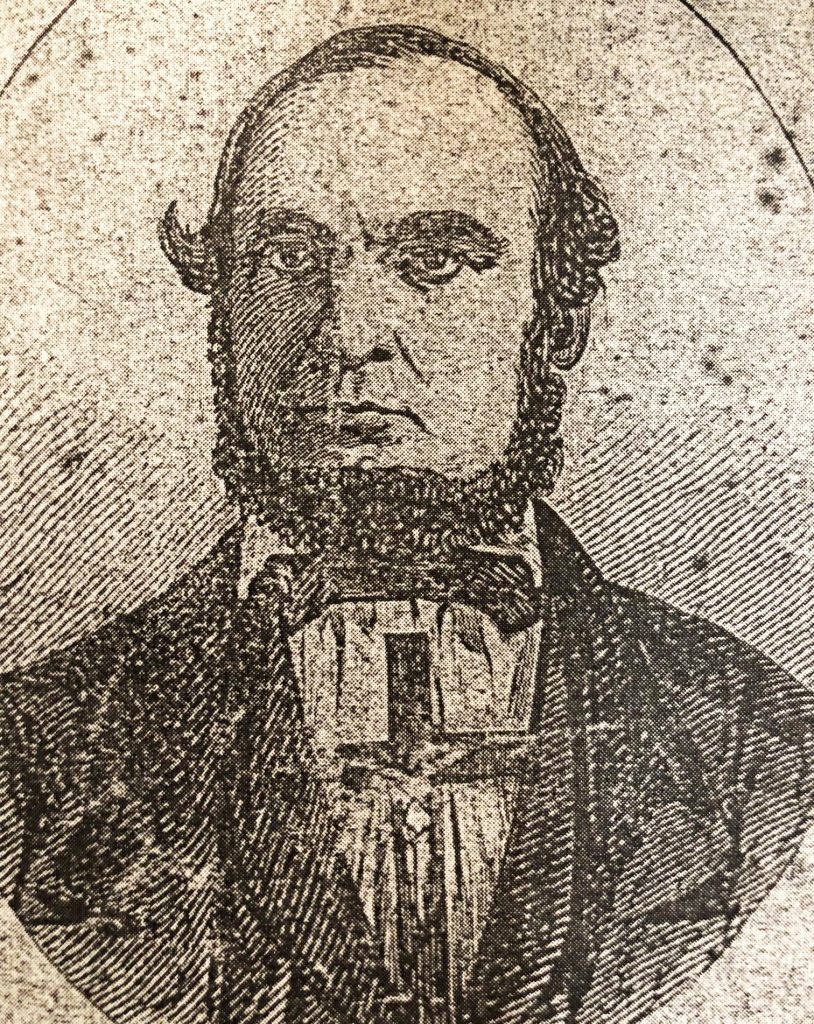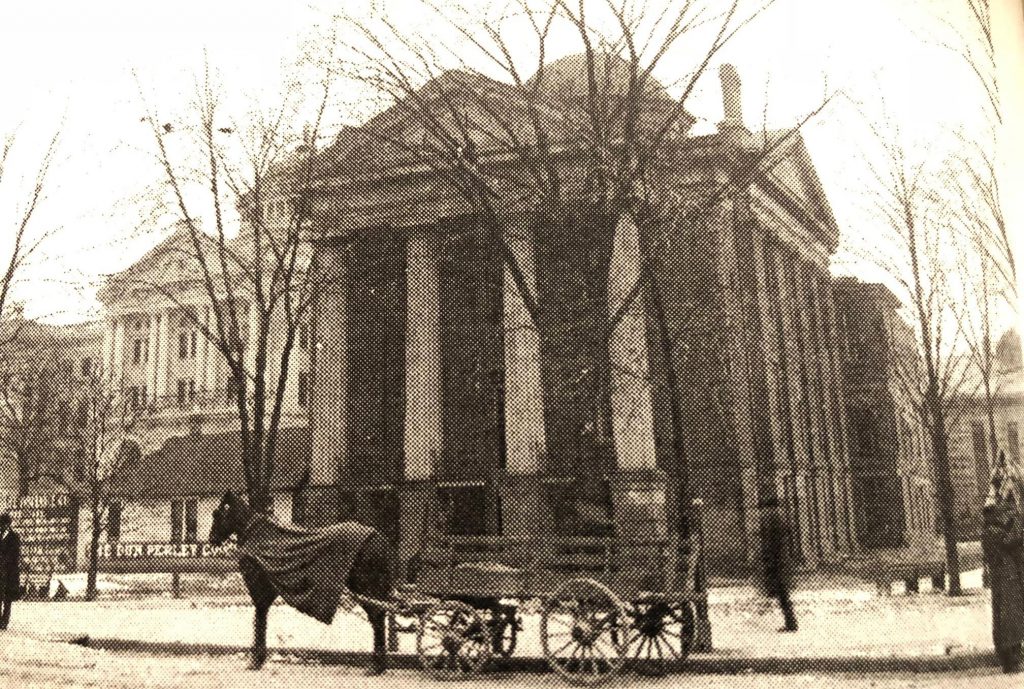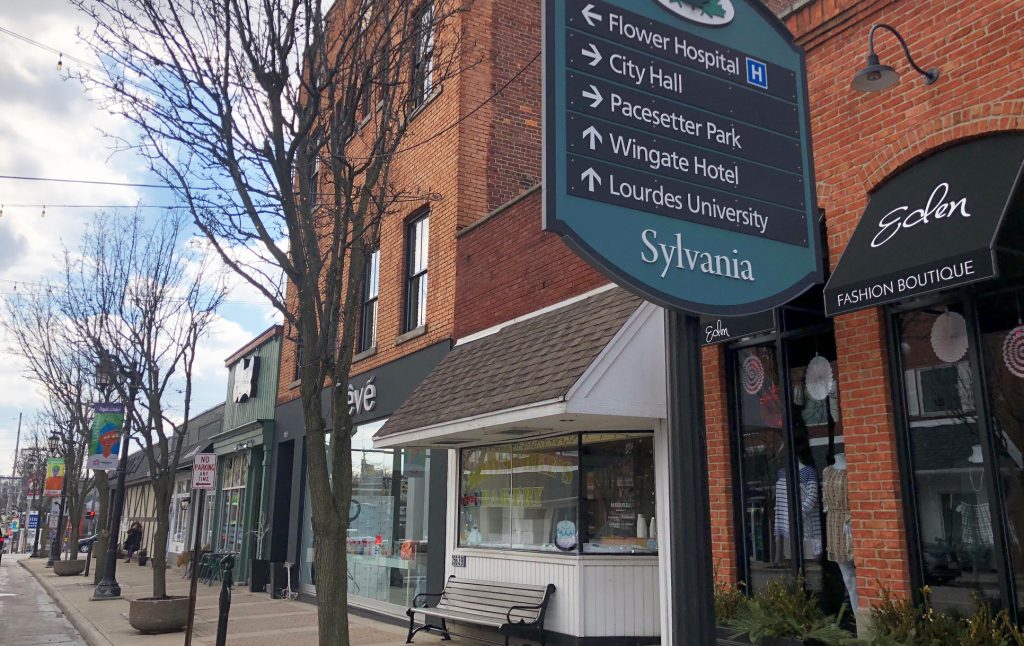SYLVANIA, Ohio — His full name was Return Jonathan Meigs Ward. Even the sound of it is super creepy. The story behind the name is even creepier and bizarre beyond comprehension. A sensational murder mystery that played out on the pages of the Daily Toledo Blade in 1857, culminated in the gloomy gallows of the Lucas County Courthouse that same year. But before Return Ward was swinging from a noose with thousands crowded around outside the courthouse, the relatively short trial revealed that he had killed two others, maybe more. Ohio’s first known serial killer was now legend. The chilling and quite descriptive quotes you’re about to read in the lines below are direct excerpts from the murderer’s confession.

But before Ward makes his gruesome, yet articulate confessions, let’s take a moment to set the stage. Already a man with a troubled and disturbing past, he was a tailor by trade and lived with his wife Olive Davis in a 16 by 20 wooden house on the west side of Division Street (present day Main Street) in Sylvania, Ohio. Olive’s two children, a 9-year-old boy and a 3-year-old girl from a previous marriage, also lived in the home. Unfortunately, the children were a continual irritant for Ward. They family was also poor which surely didn’t help alleviate the situation.
Whether Ward’s abusive behavior was a result of his troubled upbringing, or possibly some other unknown thing caused the wiring in his head to go bad, we cannot know. What we do know is that not long into the marriage, Olive knew she was in danger and needed to get out; so she left Ward, traveling to Adrian, Michigan by train with her two children.
But even before Olive left, she sent her boy to live with her former brother-in-law, and her daughter with a nearby friend. Not long thereafter, the little girl returned and was soon sent back again.
“Two or three days after this difficulty about the child, I found that my wife was missing. I immediately ran down to the depot. I accosted her and asked her what she intended to do; she replied that she was going away. I detained her trunk; and, as she got into the car, I seized her bonnet; and she went off without any clothes except those that she had on her person.”
Ward was now revealing some serious red flags for all to see, serious enough that Olive dashed away on the train with nothing but the clothes on her back…not even her bonnet. And it wasn’t long before Ward was on a train to Adrian in attempt to track her down and bring her back.
“She said that she did not like me well enough to live with me. Olive “finally concluded not to return, and I went back without her.”
Then Ward paid a man to go to Adrian on his behalf with instructions that if she’d come home, he’d pay for her train fare back to Sylvania.
“His success was better; and he brought me word that she would come back if I sent her money. This I did immediately, and I met her at the train at 12 o’clock on Saturday night, January 31st, and we went together to my house.”

After Olive spent the next day gathering her things for what she hoped would be her final departure, Ward caught wind from the neighbors that she did not intend to stay.
“She told me plainly that she did not intend to stay with me, but should return to Adrian. That declaration aroused all the vile passions of my nature. From the moment she uttered it, I was fully resolved that she should never leave my house alive.
“On Tuesday evening (Feb. 3), before going to bed, we had high words about her going away, and both went to bed angry.”
Ward’s twisted thoughts were now at a fever pitch, and if he was going to act, he had decided it was now or never. It was now Wednesday, February 4th. Ward got up at 6 a.m. and built a fire. As soon as the house got warm, Olive got out of bed.
“The old subject of controversy was revived, and I at once determined that then and there I would put my resolves into execution. Accordingly, as she stooped down to put on her shoes, I seized a smoothing iron, and while her back was towards me, I stepped up to her unperceived; but before I struck the fatal blow, I paused a moment to consider. I felt very strangely–I hesitated to strike–but, just then, a movement of her body made it necessary for me to decide at once; my resolution was remembered, and, drawing up my arm, I struck her a blow on the right side of her head, near the top, which broke her skull and felled her to the floor. The blood flowed considerably from the wound, and from her mouth and nose. She struggled a little, and did not speak after I struck her, and died in about 15 minutes.
“It was now nearly seven o’clock, and, although the doors to the house were all locked, I had good reason to fear some unexpected intrusion might disclose my wickedness. I therefore rolled up the body in two quilts and shoved it under the bed.”
After going out for a pound of sugar, Ward returned home and began to reflect on what he had done.
“In that solitary house; alone with my dead wife, murdered with my own hand, and still weltering in her blood; and with my guilt and fear of detection ever before me, my situation was not to be envied.”
Ward was also conjuring up a plan to hide the crime by disposing of the body.
“It then occurred to me that perhaps I might burn it. Something had to be done; no time was to be lost.”
What happened next is even more twisted.
“I went to the bed and dragged out the body to a position near the stove, and began to tear off her clothes. Having completely disrobed her, I cut open the abdomen, and, taking out the bowels, crowded them into the stove, where I had made an extra fire for the occasion. As they got hot they appeared to fill with wind, and explode, making so much noise in their confined situation that I feared the neighbors would hear, and I should be exposed. By pricking holes in the portions which seemed to be most inflated, I succeeded in obviating this difficulty, and in the course of a couple of hours the bowels were wholly consumed.
“I next proceeded, in the same way, with the heart, lungs, liver, etc., and by night had made considerable progress in my disgusting work. The blood I had bailed out with my hands and put in a kettle, soaking up what I could not otherwise dispose of, by means of her skirts and undergarments, and then burning it in the stove.
“Having disposed of the lighter parts of the body, I next undertook to unjoint the legs at the hips. I took the legs and divided them at the knees, and put them in a large wash boiler attached to the stove. I then unjointed the arms in the same way, and after cutting them in two at the elbows, packed them in the boiler. Then I cut out the collar bone, the breast bone, the portions of the ribs, and packed them in the boiler, burning up only such small portions as the fire would readily consume. In getting out the ribs and breaking the body I was obliged to use blows, which were probably the noises heard by the neighbors, and spoken of at the trial. Finally, I took the head off and put it in the boiler. I then covered the boiler over with a cloth and shoved it under the bed.”
After sleeping all night on his “work table”, Ward ventured out Thursday to see what the scuttlebutt would be on the streets. Knowing his wife would soon be missed, he came up with some cockamamie plan that he had sent her off on the train with some money Tuesday night, aboard eastbound cars to California. Ward spent the night Thursday with his sister’s daughter, Mrs. Caroline Lewis, ate breakfast and returned home Friday morning to continue his work.
“After kindling a fire I drew it out and cut the flesh from the larger bones, those of the legs, thighs, arms and ribs, and put the bones, with portions of the flesh, into the stove.”
After spending the night again Friday with Mrs. Lewis, Ward ventured out once more the next day and soon learned that he was suspected of having committed the murder, and that his premises were going to be searched Saturday morning. Remarkably, during the search, they failed to discover the boiler, still with most of the body parts, under the bed. Not satisfied, the men also said they’d be back for another search.
“During Saturday I was too much excited by what I heard in the street, and by the search of my premises, to do anything further regard to the remains.”
Ward went back to Mrs. Lewis’s house; but by now they had also suspected him of the crime and they refused him at the door. Neighbors around town had noticed a strange black smoke coming from Ward’s chimney, and with it, a foul odor. Ward also learned that another search was coming Monday morning. He went back home Saturday night and contemplated his next move.
“Sunday morning, I built a large fire in the stove, and immediately commenced cutting off slices of flesh and throwing them in the fire. When Monday came I was fully ready to brave out the proposed search; but no further search was made on that day, or through the week, till Saturday. Meantime I had abundant leisure to remove any blood stains or other traces of the murder which remained.”

By now, word had come down from Adrian that Olive wasn’t there, and had not been there since she left on January 31st. Ward’s home was searched again Saturday, February 14th. He was also issued a warrant for his arrest; but with no real evidence found, he was released. On Monday, a more thorough search was performed. Human bones were then discovered in a pile of ash at the back of the lot.
“Among the pieces of the bones found, was a portion of the jaw. How so large a piece of bone escaped my notice, I cannot tell. I continued steadily to deny any knowledge of my wife’s death; but the people of Sylvania had made up their minds that I was guilty. I was kept under guard at Sylvania till the next day, when I was brought down and lodged in jail (Toledo’s Lucas County Courthouse), to await the action of the Grand Jury and the court.”
During an interview the next day, Ward made his full confession.
“I immediately saw that, as my counsel, they had a right to an honest answer, and that such an answer was important to the proper conduct of my defense; so I replied that a search would be useless. When I saw them on the next day I gave them a full and particular account of all that had transpired in reference to her death, and the manner of concealing her remains.
“My trial commenced on Thursday, the 16th of March, 1857, and was brought to a close by my conviction on the 27th…they had found me GUILTY OF MURDER IN THE FIRST DEGREE.”
“I am now within about two weeks of my execution. I would gladly avoid the penalty of my crimes, but I feel that my sentence is just, and that my country has a right to make my wickedness a warning to others. I have sought, in my extremity, the consolations of religion; have had my sins washed away by baptism; have partaken of the body and blood of Christ in the Holy Eucharist, and shall die in the faith of the Catholic Church.”
The following passage appeared as part of an article in the Daily Toledo Blade on March 26, 1857. Pretty heavy content for its time.
The murder is one of the most brutal, horrid and disgusting, in all the annals of crime. A husband not only murders his wife, after cold-blooded premeditation, but he sits up nights, with his doors locked, cuts her into small pieces, and burns up her remains in the stove. The process occupied several days, in which time he drew largely on the shops around for shavings, and the unsavory scent went forth from the chimney. Ward has not yet had his sentence, but will be hung by the neck till he is dead, dead!
On the heels of a violent thunderstorm to start the day, at 11 o’clock on the morning of June 12, 1857, 42-year-old Return Jonathan Meigs Ward was summoned from his prison cell and escorted to the gallows. Colonel Lucian Lathrop, also of Sylvania, secured his limbs.
Ward was dressed in a white robe, white pants and white slippers, with a cross around his neck, which he held in his hand. After he rambled on for a bit, the noose was placed around his neck by Sheriff Springer. He kissed one of the priests and arose to his feet saying “I am not afraid to die.” From the time until the fall, he was praying, uttering confession, and muttering incoherent sentences. The cap was drawn over his face by the sheriff; and he repeated a prayer after the priest. His last words were “Oh my God, I am thine! Thou art mine!”
As he said those words, at precisely five minutes before 12 o’clock, the bolt was drawn and Ward dropped straight down, and hung motionless–only one slight motion of the feet and all was over. Ward was dead. We immediately left the place, and the incoherent ravings, the nervous and excited appearance of the murderer on the gallows, the still, white form of the slowly swinging body–none of those who were present will ever forget.
During the trial, Ward also admitted to killing two men, one in 1851 and another in 1852, the latter with an axe to the head. After he unjointed the legs, he fit the corpse into a dry goods box and drove 60 miles north where he disposed of the body in the Huron River.

In 1936, lifelong Sylvania resident Albert H. Randall wrote a letter describing what the entire west side of Main Street between Monroe and Maplewood looked like in 1886 before fire destroyed the west side of the block in 1887.
“My earliest recollection of Sylvania’s Main Street was Pop Polley’s Saloon, situated where the Council Chambers now stands (now a hardware store). Coming down the street (to the north) the next building was occupied by J.M. Bonough’s harness shop. Next was J.H. Parker’s grocery store. The next building had been occupied as a tailor shop in which a man murdered his wife and burned her body; we boys used to give this place a wide berth as we believed her spirit came back and prowled around at night.”
As a current resident on the same west block on Main Street, there’s not a time when I drive or walk by that I don’t think about what happened here in 1857. On particular nights when I’m out walking, I too have been known to give this area “a wide berth.”
Source: Murder In Sylvania, Ohio, As Told in 1857, by Gaye E. Gindy, copyright 2007.
@DonRadebaugh on Twitter, or History Mystery Man on Facebook.


I have read many true crime books over the years. This is another fact about my hometown that I was not aware. Thank you again Don for your historical post.